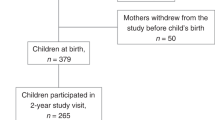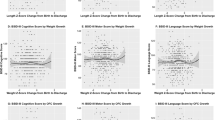Abstract
Background/Objectives:
Adverse developmental consequences of low-birth-weight (LBW) infants have been frequently reported from developed countries where most of them are preterm. Few reports are available from developing countries, where the problem is huge and newborns are mostly term babies. We aimed to compare mental and psychomotor development and behavior of LBW Bangladeshi infants with those of normal-birth-weight (NBW) infants.
Subject/Methods:
Secondary data analyses from a randomized controlled trial of fish oil supplementation during pregnancy on infants' development at 10 month. There was no effect of supplementation on infants' development. All LBW (n=66) and NBW (n=183) infants were assessed for their mental development index (MDI), psychomotor development index (PDI), behavior and quality of psychosocial stimulation received at home. Socioeconomic information and anthropometric measurements were available, and bivariate and multivariate analyses were performed to examine group differences.
Results:
LBW infants scored significantly lower than NBW infants on MDI, PDI, activity and emotional tone. They came from comparatively poorer families and had lower gestational age than the NBW infants. After controlling for possible confounders, the NBW infants had significantly higher MDI (B=2.7, s.e.=1.1, 95% confidence interval (CI): 0.6–4.8), PDI (B=3.5, s.e.=1.3, 95% CI: 1.0–6.0) and activity (B=0.5, s.e.=0.2, 95% CI: 0.1–0.9) scores. Furthermore, in a subgroup analyses, a consistent pattern of developmental delay was also noted in favor of term-LBW infants.
Conclusions:
In a poor-urban Bangladeshi community, LBW infants had significantly lower mental and psychomotor developments and were less active than NBW infants at 10 months of age.
This is a preview of subscription content, access via your institution
Access options
Subscribe to this journal
Receive 12 print issues and online access
$259.00 per year
only $21.58 per issue
Buy this article
- Purchase on Springer Link
- Instant access to full article PDF
Prices may be subject to local taxes which are calculated during checkout


Similar content being viewed by others
References
Anderson PJ, Doyle LW (2008). Cognitive and educational deficits in children born extremely preterm. Semin Perinatol 32, 51–58.
Aylward GP, Pfeiffer SI, Wright A, Verhulst SJ (1989). Outcome studies of low birth weight infants published in the last decade: a metaanalysis. J Pediatr 115, 515–520.
Bayley N (1993). Bayley Scales of Infant Development, 3rd edn. The Psychological corporation: San Antonio, TX.
Black MM, Baqui AH, Zaman K, Persson LA, Arifeen SE, Le K et al. (2004). Iron and zinc supplementation promote motor development and exploratory behavior among Bangladeshi infants. Am J Clin Nutr 80, 903–910.
Caldwell BM (1967). Descriptive evaluation of child development and of developmental settings. Pediatrics 40, 46–52.
Fattal-Valevski A, Leitner Y, Kutai M, Tal-Posener E, Tomer A, Lieberman D et al. (1999). Neurodevelopmental outcome in children with intrauterine growth retardation: a 3-year follow-up. J Child Neurol 14, 724–727.
Fitzhardinge PM, Steven EM (1972). The small-for-date infant. II. Neurological and intellectual sequelae. Pediatrics 50, 50–57.
Gardner JM, Walker SP, Powell CA, Grantham-McGregor S (2003). A randomized controlled trial of a home-visiting intervention on cognition and behavior in term low birth weight infants. J Pediatr 143, 634–639.
Gorman KS, Pollitt E (1992). Relationship between bodyweight and body proportionality at birth, growth during the first year of life, and cognitive development at 36, 48, and 60 months. Infant Behav Dev 15, 279–296.
Grantham-McGregor SM (1998). Small for gestational age, term babies, in the first six years of life. Eur J Clin Nutr 52 (Suppl 1), S59–S64.
Grantham-McGregor SM, Fernald LC (1999). Shethuraman K effects of health and nutrition on cognitive and behavioral development in children in the first three years of life. Food Nutr Bull 20, 53–98.
Grantham-McGregor SM, Lira PIC, Ashworth A, Morris SS, Assuncao AMS (1998). The development of low birth weight term infants and effects of the environment in Northeast Brazil. J Pediatr 132, 661–666.
Hamadani J, Fuchs GJ, Osendarp SJM, Huda SN, Grantham-McGregor SM (2002). Zinc supplementation during pregnancy and effects on mental development and behavior of infants: a follow-up study. Lancet 360, 290–294.
Hamadani J, Fuchs GJ, Osendarp SJM, Khatun F, Huda SN, Grantham-McGregor SM (2001). Randomised controlled trial of the effect of zinc supplementation on the mental development of Bangladeshi infants. Am J Clin Nutr 74, 381–386.
Jiang ZD, Wu YY, Zhen MS, Sun DK, Feng LY, Peng YM et al. (1991). Development of early and late brainstem conduction time in normal and intrauterine growth retarded children. Acta Paediatr Scand 80, 494–499.
Kardjati S, Kusin JA, De With C, Renqvist UH (1991). Low birth weight babies under village conditions: feeding pattern, growth and motor development. Paediatr Indones 31, 84–98.
Lasky RE, Lechtig A, Delgado H, Klein RE, Engle P, Yarbrough C et al. (1975). Birth weight and psychomotor performance in rural Guatemala. Am J Dis Child 129, 566–569.
Leitner Y, Fattal-Valevski A, Geva R, Bassan H, Posner E, Kutai M et al. (2000). Six-year follow-up of children with intrauterine growth retardation: long-term, prospective study. J Child Neurol 15, 781–786.
Low JA, Handley-Derry MH, Burke SO, Peters RD, Pater EA, Killen HL et al. (1992). Association of intrauterine fetal growth retardation and learning deficits at age 9–11 years. Am J Obstet Gynecol 167, 1499–1505.
Lundgren EM, Tuvemo T (2008). Effects of being born small for gestational age on long-term intellectual performance. Best Pract Res Clin Endocrinol Metab 22, 477–488.
Padidela RNR, Bhat V (2003). Neurobehavioral assessment of appropriate for gestational and small for gestational age babies. Indian Ped 40, 1063–1068.
Parkinson C, Wallis S, Harvey D (1986). School achievement and behavior of children who were small-for-dates at birth. Dev Med Child Neurol 28, 498–505.
Paz I, Gale R, Laor A, Danon YL, Stevenson DK, Seidman DS (1995). The cognitive outcome of full-term small for gestational age infants at late adolescence. Obstet Gynecol 85, 452–456.
Pryor J, Silva PA, Brooke M (1995). Growth, development and behaviour in adolescents born small-for-gestational-age. J Paediatr Child Health 31, 403–407.
Pryor JE (1992). Physical and developmental status of preschool small-for-gestational-age children: a comparative study. J Paediatr Child Health 28, 162–167.
Roth S, Chang TC, Robson S, Spencer JA, Wyatt JS, Stewart AL (1999). The neurodevelopmental outcome of term infants with different intrauterine growth characteristics. Early Hum Dev 55, 39–50.
Tandon A, Kumari S, Ramji S, Malik A, Singh S, Nigam VR (2000). Intellectual psycho-educational and functional status of low birth weight survivors beyond 5 years of age. Indian J Pediatr 67, 791–796.
Tofail F, Kabir I, Hamadani JD, Chowdhury F, Yesmin S, Mehreen F et al. (2006). Supplementation of fish-oil and soy-oil during pregnancy and psychomotor development of infants. J Health Popul Nutr 24, 48–56.
United Nations Children's Fund and World Health Organization (2004). Low Birthweight: Country, Regional and Global Estimates. UNICEF: New York, pp 1–27. http://www.childinfo.org/files/low_birthweight_from_EY.pdf (accessed 11 August 2010).
Valero De Bernabé J, Soriano T, Albaladejo R, Juarranz M, Calle ME, Martínez D et al. (2004). Risk factors for low birth weight: a review. Eur J Obstet Gynecol Reprod Biol 116, 3–15.
Villar J, Smeriglio V, Martorell R, Brown CH, Klein RE. (1984). Heterogeneous growth and mental development of intrauterine growth-retarded infants during the first 3 years of life. Pediatrics 74, 783–791.
Victora CG, Adair L, Fall C, Hallal PC, Martorell R, Richter L et al. (2008. Maternal and Child Undernutrition Study Group. Maternal and child undernutrition: consequences for adult health and human capital. Lancet 371, 340–357.
Walker SP, Chang SM, Powell CA, Grantham-McGregor SM (2004). Psychosocial intervention improves the development of term low-birth-weight infants. J Nutr 134, 1417–1423.
Walker SP, Wachs TD, Gardner JM, Lozoff B, Wasserman GA, Pollitt E et al. (2007). International Child Development Steering Group. Child development: risk factors for adverse outcomes in developing countries. Lancet 369, 145–157.
Westwood M, Kramer MS, Munz D, Lovett JM, Watters GV. (1983). Growth and development of full-term nonasphyxiated small-for-gestational-age newborns: follow-up through adolescence. Pediatrics 71, 376–382.
WHO Multicentre Growth Reference Study Group (2006). WHO Child Growth Standards: Methods and Development. World Health Organization: Geneva. Available at: http://www.who.int/childgrowth/ (accessed 14 June 2010).
Wolke D, Skuse D, Mathisen V. (1990). Behavioral style in failure to thrive infants: a preliminary communication. J Ped Psychol 15, 237–254.
Zwicker JG, Harris SR (2008). Quality of life of formerly preterm and very low birth weight infants from preschool age to adulthood: a systematic review. Pediatrics 121, e366–e376.
Acknowledgements
ICDDR,B acknowledges with gratitude the commitment of the World Bank to the Centre's research efforts. We are grateful to the mothers and children who participated in the study; without their help this research could not have been possible. This research was funded by the World Bank (Grant no. 00251).
Author information
Authors and Affiliations
Corresponding author
Ethics declarations
Competing interests
The authors declare no conflict of interest.
Additional information
Guarantors: Syed N Huda and Jena D Hamadani.
Contributors: The hypothesis for the secondary data analyses was developed by FT, JDH and SNH. The fieldwork was conducted and supervised by FM, FT and JDH by the help of other supporting staff. FT, JDH, AZTA, MH and SNH did the statistical analysis. FT wrote the first draft and coordinated completion of the paper with JDH, AZTA, MH and SNH. FT had full access to all the data in the study and takes responsibility for the integrity of the data and the accuracy of the data analysis. All authors critically commented on and edited earlier drafts and approved the final version of the paper.
Rights and permissions
About this article
Cite this article
Tofail, F., Hamadani, J., Ahmed, A. et al. The mental development and behavior of low-birth-weight Bangladeshi infants from an urban low-income community. Eur J Clin Nutr 66, 237–243 (2012). https://doi.org/10.1038/ejcn.2011.165
Received:
Revised:
Accepted:
Published:
Issue Date:
DOI: https://doi.org/10.1038/ejcn.2011.165
Keywords
This article is cited by
-
Cognitive and motor outcomes in children born low birth weight: a systematic review and meta-analysis of studies from South Asia
BMC Pediatrics (2019)
-
Maternal exposure to air pollutants and birth weight in Tehran, Iran
Journal of Environmental Health Science and Engineering (2019)
-
Developmental performance of hospitalized severely acutely malnourished under-six children in low- income setting
BMC Pediatrics (2017)
-
Febrile illness and pro-inflammatory cytokines are associated with lower neurodevelopmental scores in Bangladeshi infants living in poverty
BMC Pediatrics (2014)



